2006 VOLKSWAGEN GOLF PLUS engine
[x] Cancel search: enginePage 130 of 541
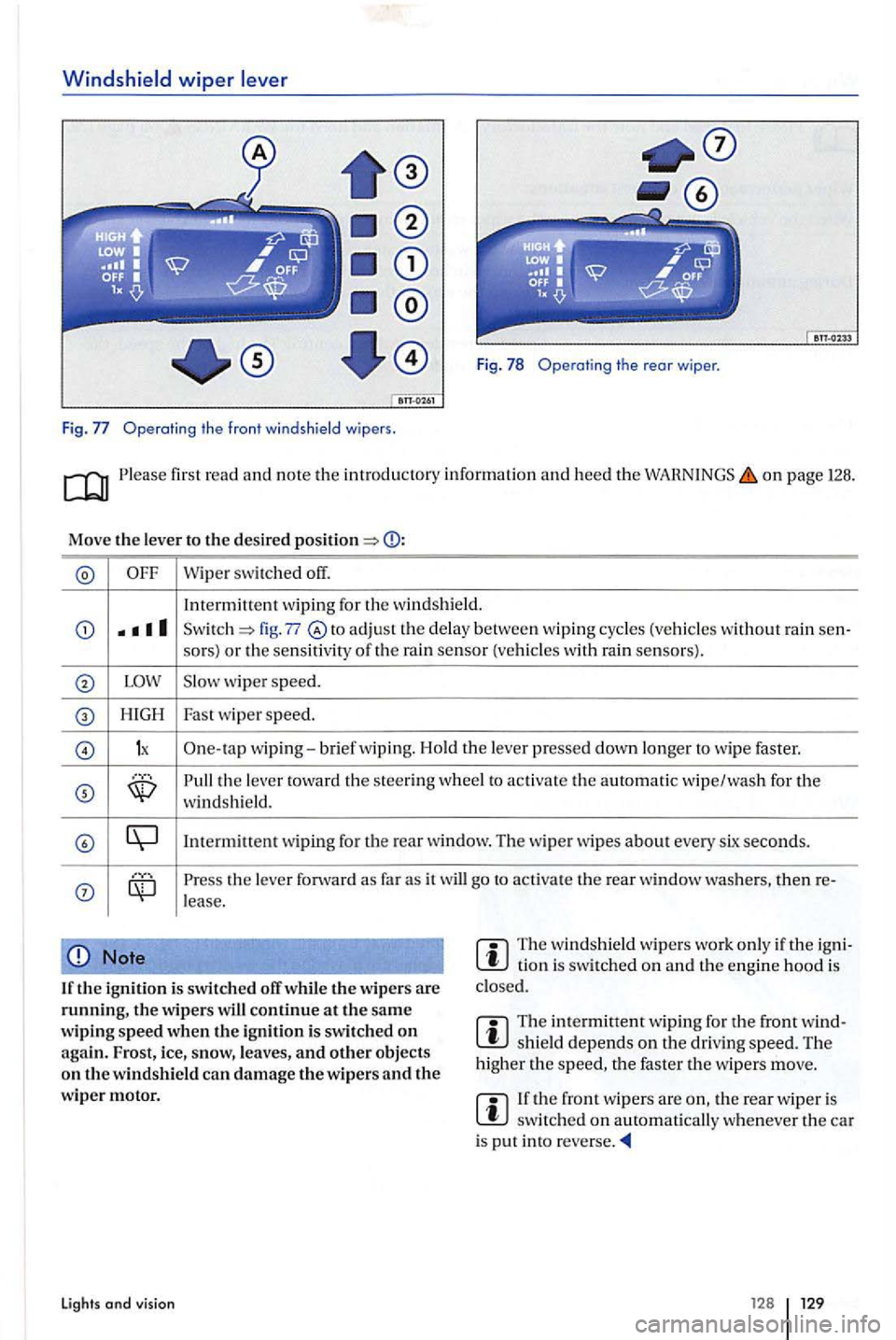
Windshield wiper lever
Fig . 78 Operating the rear wiper .
Fig. Operatin g t he front windsh ie ld wipers .
on page 128.
Move the leve r to t he des ired
Wipe r switched off.
In term itt
ent wiping for the w ind shield.
fig. 77 to adj ust the delay between wip ing cycles (vehicles wit hout rain sen-
so rs) or the sensit iv ity of th e rain sensor (vehicle s w ith rain senso rs).
w iper speed.
H IGH Fast wipe r speed.
1x One-ta p wip ing-brief wiping. Hold th e lever presse d down longer to wipe faster.
the le ve r towa rd t he stee ring whee l to activat e the au toma tic wipe/wa sh for the windsh ie ld.
the leve r forward as far as it will go to ac tiva te the rear window then re-lease.
Note
If the ig n it io n i s swi tc h ed off whil e the w ipers are th e w ipers continue a t the sa me
w ip ing sp eed when the ign ition i s swi tched on agai n.
The w in ds hield wipe rs work only if th e tio n i s sw itched on and th e engine hood is
clo sed.
Th e intermittent wip ing for the front shield depends on the driving speed. The
h igh er the the faster th e wipers move.
th e rear w ip e r is s witc hed on automatically w henever the car is pu t in to
Lights and visi o n 12 8
Page 133 of 541
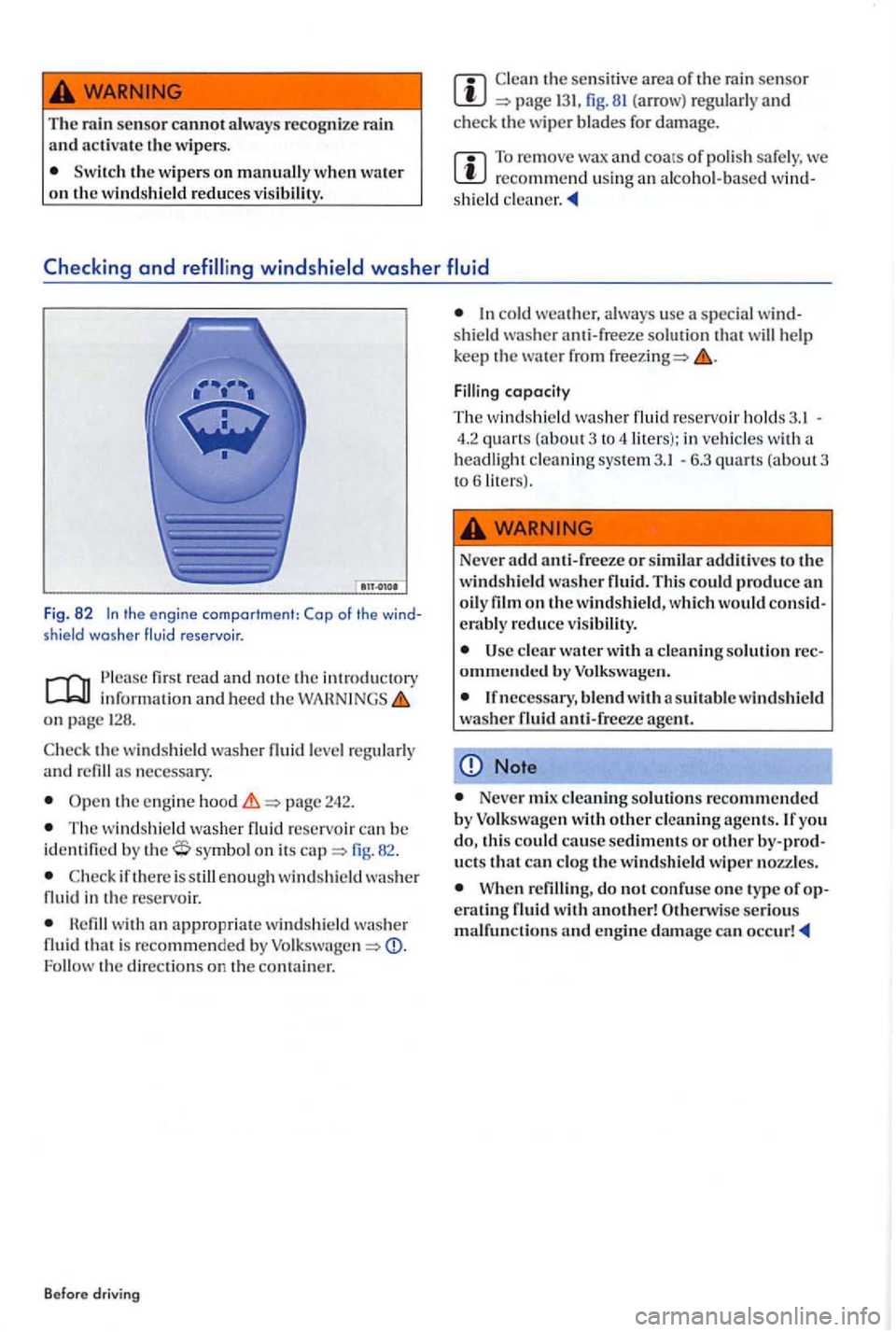
The sensor cannot always recognize rain and activate the wipers.
Switch the wipers on manually when water on the windshield reduces visibility.
131, fig. 81 (arrow) regularl y and check the wipe r b lades fo r damage.
T o remove wax and coats of polish safely, we recommend usin g a n alcoho l-based s hi eld
Fig. 82 the engine compartme nt: Cap of the shield washer fluid reservoir .
Ple ase first read and the int rod uctory information and heed th e on pa ge
the windshi eld was her necess ary.
page 242.
The wind shi eld washer fluid reservoi r can be identifi ed by symbol on its fig. 82.
H efill w ith an appropriat e windshie ld was he r
fluid i s recommended by Follow th e directio ns on the co ntainer.
Before driving
co ld weather. u sc a speci al
Filling capacity
The w indshi eld washer fluid reservoir holds 4.2 quarts (a bout 3 to 4 liters ): in vehicles with headlight cleaning sys te m - 6.3 quarts (about3 to 61it e rs).
Never add anti-freeze or simila r to the windshie ld was her fluid . This could produce
erabl y reduce v is ibility.
Note
Neve r mix cleaning solutions recommended by Volkswagen with other cl eaning agcnts.lfyo u
ucts that can clog the windshield wiper nozz les.
When refilling, do not confuse one type of
Page 141 of 541
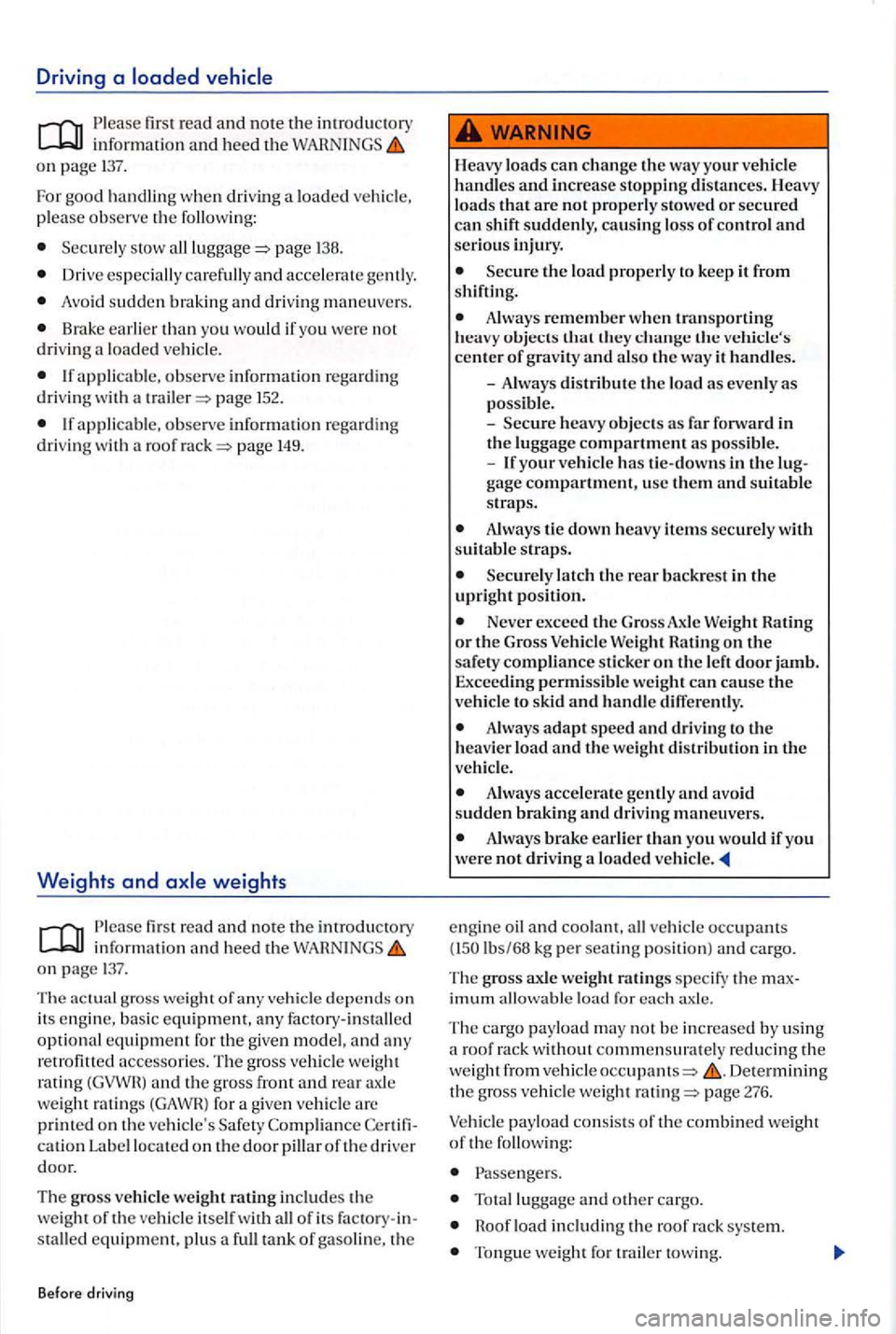
Driving a
first read and note the introductory informat io n and heed the WARNINGS on page 137.
F
or good h andli ng w he n driving a loa ded ve hicl e,
please observe the following:
Secure ly stow page 138.
Dr ive especially caref ully and acce le rate gently.
Avoid sudd en braking and driv ing man eu ve rs.
Brake earlier than you wou ld if yo u were not
drivi ng a loa ded vehicle.
page 152.
If applicabl e, observe information rega rdin g driv in g w ith roof page 149.
Weights and
firs t read and no te the introductory information and heed the WARNINGS o n page 137.
The gross weight of any vehicle depends on its en gin e, basic equipment, an y factory- in stalled
optional equipment for the given model, and any retrofitted accessories. T he gross vehicle weig ht
rat ing
catio n Label loca ted on the door pillar of the dri ver
door.
The gross vehicl e we ight rating includ es the
weight of the ve hicle itself w ith of its tank of gaso line, the
Before driving
lo ads can ch ange the way your vehicle
h andles and incre ase stop ping dista nces. loads that are not properly sto wed or secured can shift suddenly, causing loss of co ntrol and serio us injury.
the load prope rly to keep it from
shifting.
A lways remember w hen tra nsp o rtin g
h eavy obje cts th at th ey vehicle's cente r of gravity and also the way it handles.
- Always dis
tribute the load as eve nly as
possible. -h eavy obj ec ts as far forward in
th e luggage compartment as poss ible. -If your ve hicle has tie-downs in the
Always tie down heavy items securely wit h
s uitable straps.
Secure ly latch th e rear backrest in the upright position .
Never excee d th e Gross Axle Weight Ratin g
o r the Gross Weight Ratin g on the safe ty compliance sti cker on the left door jamb. Exceeding permissi b le weight ca n ca use the
ve hicl e to skid and ha ndl e diff erently.
Always adapt speed and drivi ng to th e
h ea vie r load and th e we ight di stribution in the vehicle.
Always accelerate gently and avo id
s udd en braking an d drivin g maneuvers.
Always brake ea rlier than yo u wo uld if you were not drivin g a loaded ve hicle .
engine oil and coola nt, lbs/68 kg per seatin g position ) and ca rgo .
T
he gross axle weig ht ra tin gs sp ec ify th e imum allowab le load for ax le.
The cargo payload may not be increased by using
a roof rack without commen surat ely reducing th e
we ig ht from vehicle Dete rmin ing
th e gross vehicle weight page 276.
pay load cons is ts of th e co mbin ed w eight of th e following:
Passe ngers.
Tota l luggage and othe r ca rgo .
Roof load including the roof rack system.
Tong ue weig ht for trailer towing.
Page 142 of 541
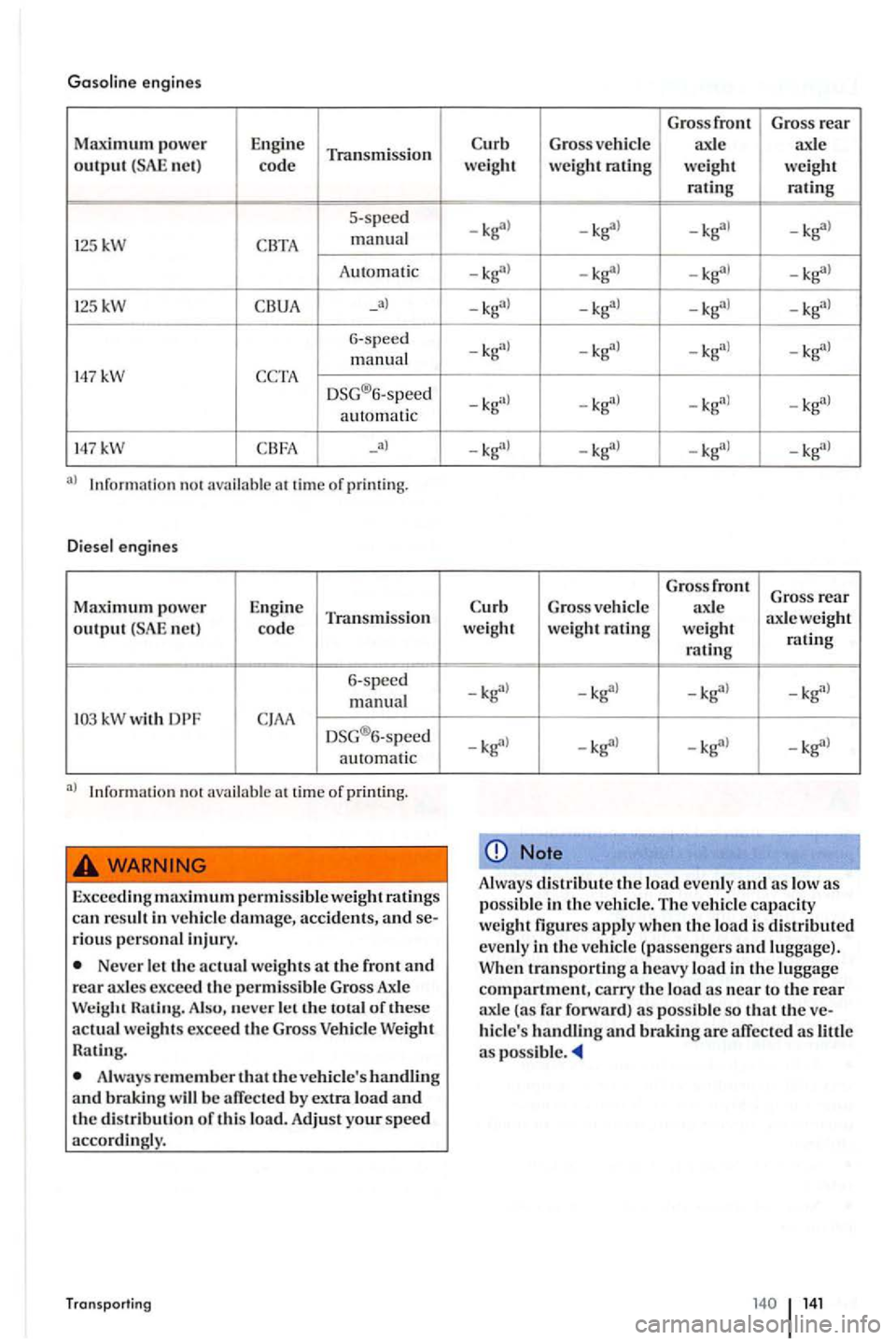
Gasoline engines
Maximum power Eng in e
Transmission output ne t)
code
5-speed
1 25kW
manual
A utomati c ---125kW _a)
6-speed
m anual
1
47kW cerA DSG® 6-speed autom atic
1 47kW
I nforma tio n not availab le
n et) code Transmission
6-speed manual
Exceed
ing m aximum permiss ibl e w eight ratin gs
ca n
Neve r let th e actual weights at the front and rea r ax les excee d th e permissible Gross Axle
remember that the ve hicle's handling and braking will be affected by extra load and the distributi on of thi s load. Adju st your s peed accordin gly.
Transporting
G ross front Gross rear
weig ht
weight ratin g weight weight
rating rating
--
---
-kg"l
Gross front
Gross rear G ross veh icle
axle
axle weight
weight weight rating weight
rating rating
-
Note
A
lwa ys distribute th e eve nly and as low as possib le in the vehicle. The ve hicl e capacity
weight figures appl y when the lo ad i s distributed
eve nly
141
Page 157 of 541
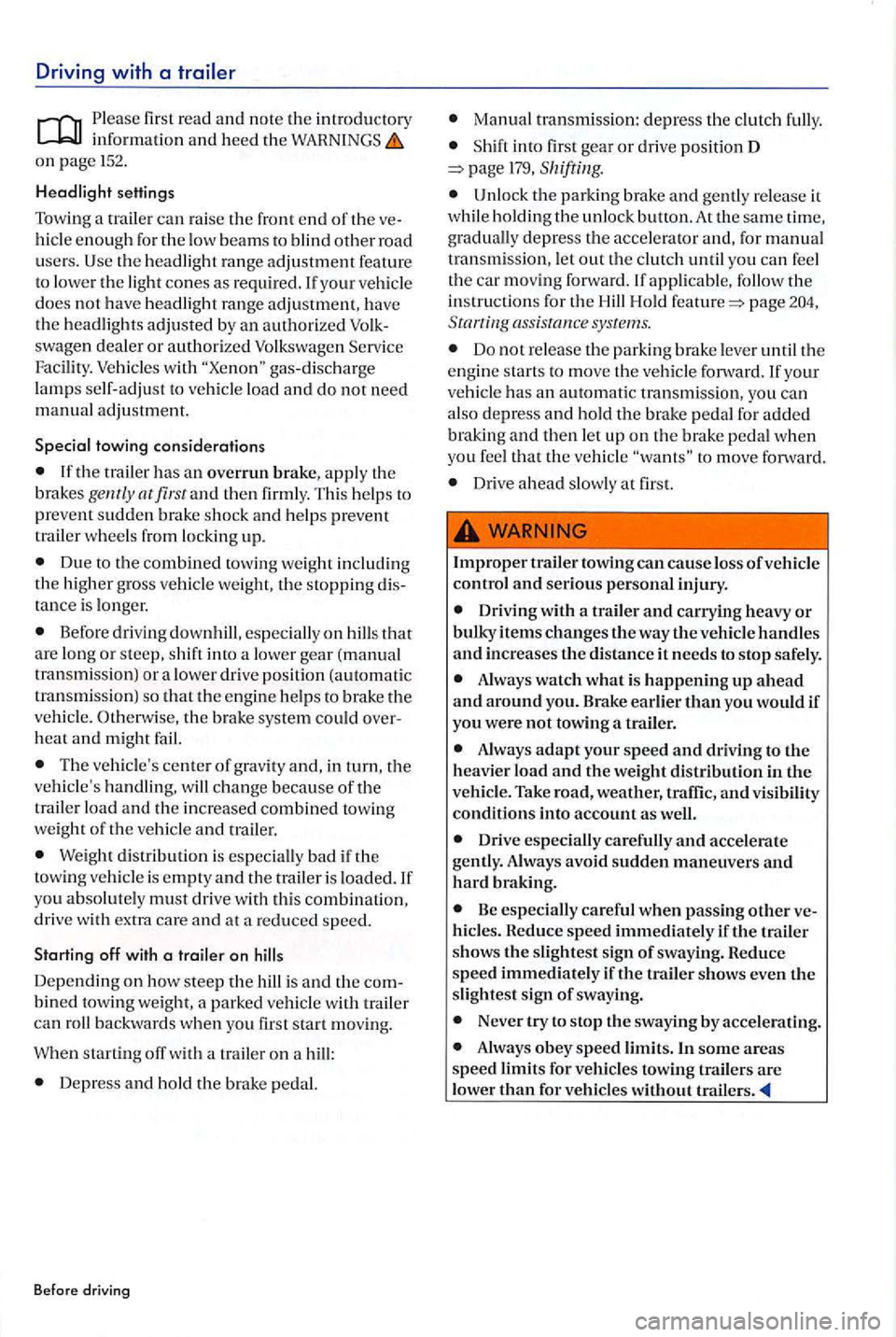
Driving with a
Please fir st read and note the introductory
o n page 152.
Headlight settings
Towing a tra
ile r can ra ise the fron t end of th e ve
hicle enough fo r the low beam s to blind other road u sers. the headlight ra nge adjustment feature
to lower the light cones as req uired . your vehicle does not have headlight range adjustment, have
the headli gh ts adjusted by an authorized Volkswage n dealer or au th orized Volkswagen Serv ice Facility . Vehicles with gas-d ischa rge lamps self-adjus t to vehicle load an d do not need manual adjustme nt.
Special towing
considerations
Due to th e combined towing weig h t includin g the hi gh er gross vehicle weight, the stopping distance is longer .
Before driving downhill , especially on hills that
a re long or steep, shift in to a lower gea r (m anual
t ransmi ssion) or a lower drive position (automatic
t ra n smi ssion) so that the eng in e helps to brake th e vehicl e. Otherwise, the b rake system could ove rheat and might fail.
The ve hicle's center of grav ity and, i n
Weigh t dis tr ibutio n i s especially bad if the
tow ing veh icle is e mpty and the traile r i s loaded. If
you absolutely must d rive with this combination , drive with extra care an d at a reduced speed.
Starting off with a trail er on hills
Depend ing o n how steep the h ill is and the combined tow ing weig ht, a parked vehicle wi th trailer can roll backwards when yo u firs t sta rt mov ing.
When sta rti
ng off with a trailer on a hill :
Depress and ho ld the brake pedal.
Befo re driv ing
Ma nual transmiss io n : d epress th e clutch fully.
Shift into fir s t gear or drive posi t ion D page 179,
Unlock the par ki ng brake and release it
w hil e ho ld ing th e unl ock butto n.
page assistance systems.
Do not re lease th e parkin g bra ke leve r until the engine sta rt s to move th e vehicle fonvard. your veh icle has an automatic t ransmissio n, yo u can
also depress a nd ho ld the brake pedal for added b raking and then letup on th e brake pedal w hen
you feel th a t the vehicle to move fo rward.
Drive ahead slowly at first.
A lways watch what i s happening up a head
and a round you. Brake earlier than you would if yo u were not to wing a trailer.
Drive especially care full y and accel erate gently. Always avoid sudde n m an euvers and h ard braking.
Be especiall y care ful when p ass ing other hicles. Reduce speed immediate ly if t he trailer
s hows the s lightes t sig n of swayin g. Reduce speed immediatel y if the t ra ile r shows even the
slightest sig n of sway ing.
Neve r try to sto p th e swayin g by accelerating.
Page 171 of 541
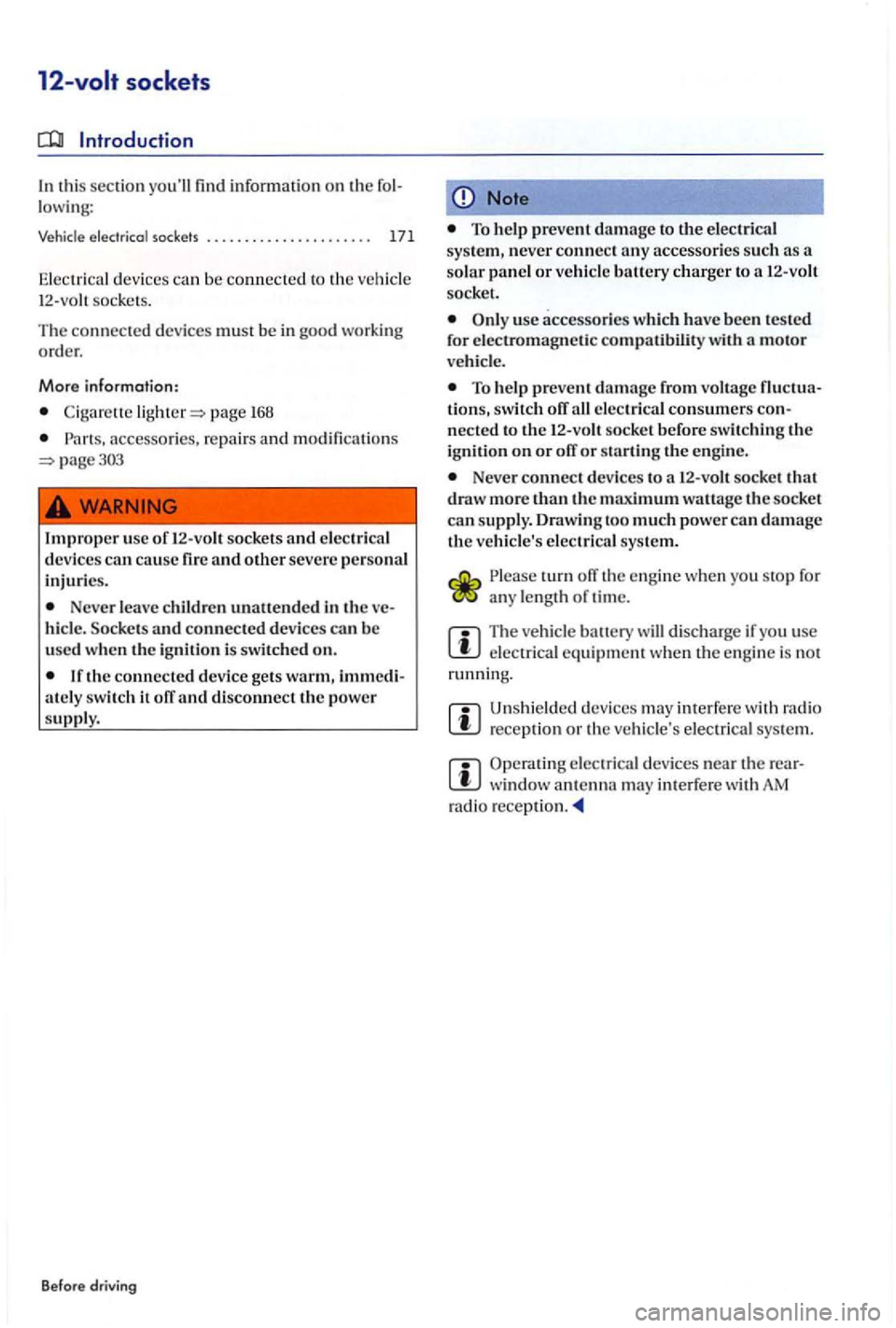
12-vol t sockets
In this section you'll find information on th e lowing:
Vehicle elec trica l sock ets . . . . . . . . . . . . . . . . . . . . . 171
Ele ctri ca l d evices can be connecte d to th e ve h icle
1 2 -volt sock ets .
Th e c
onnected device s must be in good worki ng
ord er.
More information:
page 168
accessorie s, re pairs and modification s page303
Improper u se of 12-vo lt soc kets and elec trica l
devi ces can cause fire a nd other severe pe rso nal
injuri es.
Never leave children unattende d in the hicle. Socke ts and con nected devices can be
used when the i gnitio n i s switched on.
ately switch it off and disconnect the pow er
s upply.
B efore driving
Note
To help prevent damage to the elec trical
sys tem, never connect any accessor ies su ch as a
so la r p anel
or veh icle battery charger to a 12-v olt
soc ket.
usc accessor ies whic h have bee n tested
for electromagne ti c compatibility with a motor vehicle.
To help prevent damage from voltage tions, switch off all electri cal consumers n ec ted to the 1 2-vo lt socke t be fore switchin g th e
i g nition on or off or startin g the engine .
Never connect dev ices to a 12-volt socke t that
draw mor e th an the maximum wa ttage the soc ke t can supply. Draw ing too much powe r ca n d amage the vehicle's elec trical sys te m.
turn off the engine when you stop fo r an y le n g th of tim e.
The vehicl e ba u ery will discharg e if you use elec trical equipm en t w hen the en gine is no t
running.
Uns hielded device s may interf ere with rad io reception o r th e v eh icle' s elec trica l sys tem.
Ope rating elec tr ica l devic e s near th e windo w an te n na ma y int erfere with AM
r adio re ception.
Page 172 of 541
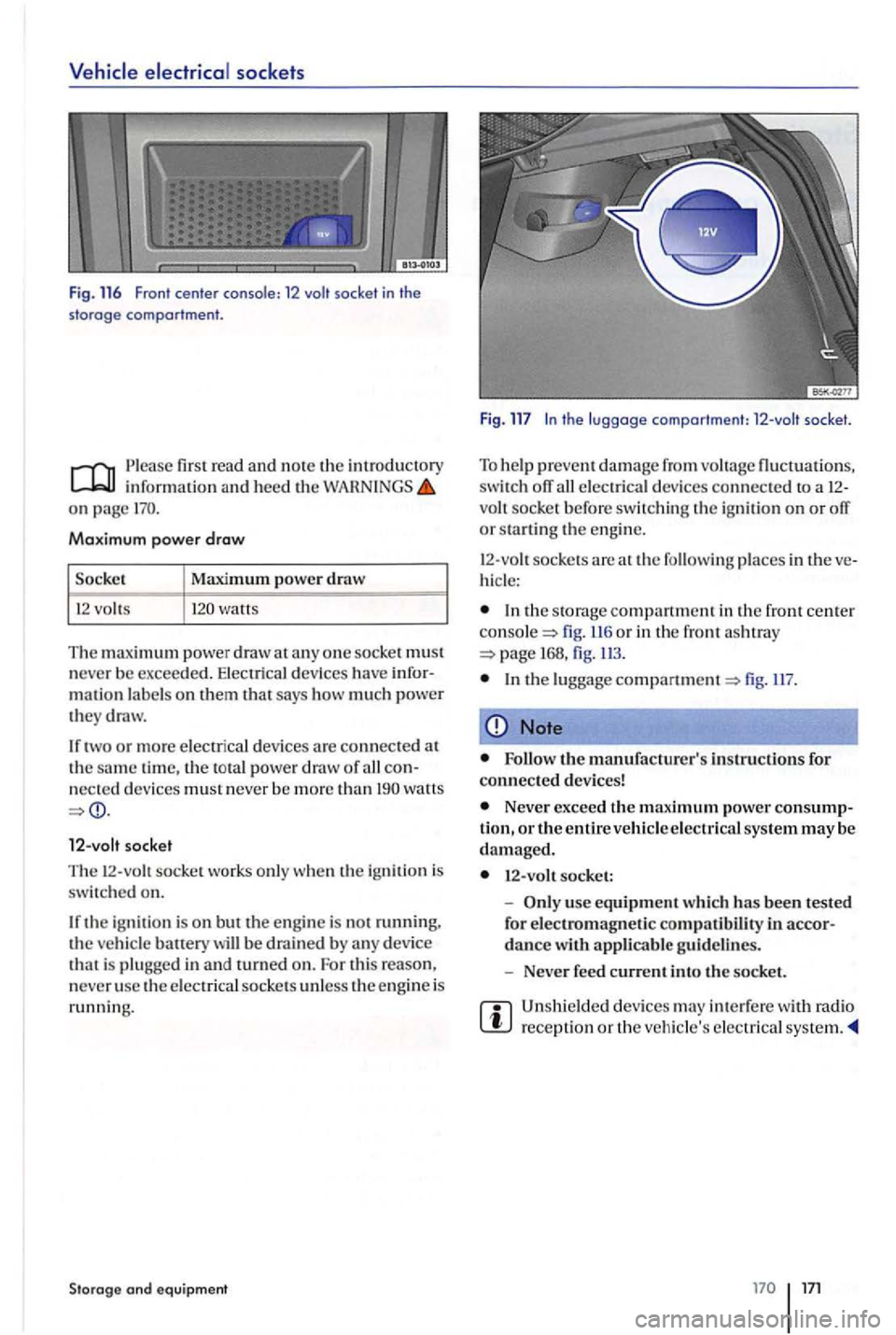
sock ets
F ig . 116 Fron t cente r conso le : 12 socket in the
sto rage comportment .
first r ea d and note the introductory information and heed the on page
Maximum power draw
watts
The maximum power draw at any one socke t must never be exceede d. Electrical devices have infor
m ation labels on them that says how muc h power they draw.
watts
socket
The socke t works only when the ig nition is swit ched on.
the ignition is on but the en g in e is not running. the ve hicl e battery will be drain ed by any device tha t is p lugged in and turned on. For this reason.
n ever use the e lectrical socke ts unl ess the engine is running.
Storage and eq uipment
Fig. 117 socket.
To h elp prevent damage from voltag e fluctuations,
swi tch off electric al devices connected to a 12-vo h socke t before swit ch ing the ignit ion on or
places in ve
hicl e:
the storage center fig . 116 or in the front ashtray 168, fig .
lugga ge fig.
Note
the manufacturer's instructions for
connected dev ic es!
Never exceed th e m aximum power consumption, or the entire ve hicl e electrical system may be damaged.
use equipment which has been tested for applicable gu ideli nes.
Neve r feed current into the socket .
Unshielded devices may interfere with radio reception or the veh icle's electrica l
Page 173 of 541
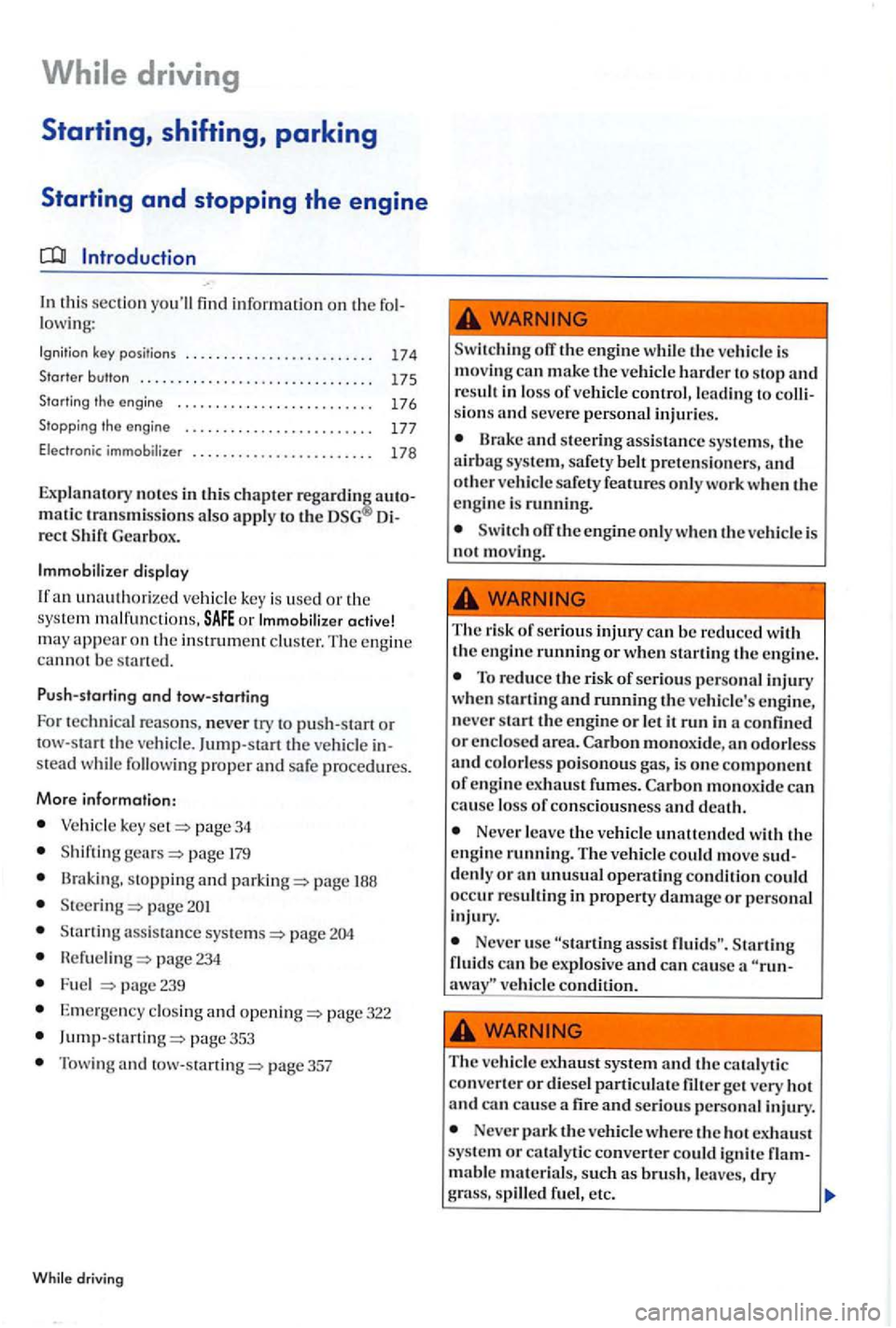
In this section yo u'll fin d information on th e
ke y p ositions . . . . . . . . . . . . . . . . . . . . . . . . 17 4
Starter button . . . . . . . . . . . . . . . . . . . . . . . . . . . . . . 175
Sta rting the engine . . . . . . . . . . . . . . . . . . . . . . . . . 176
S topping th e e ngine . . . . . . . . . . . . . . . . . . . . . . . . . 177
Electro nic immobi lizer . . . . . . . . . . . . . . . . . . . . . . . . 178
Explanatory no tes in thi s chapter regard
rec t S hift Gea rbox.
Immob i
lizer display
I f a n unauthori z
ed vehicle ke y is used or the
s y s te m malf un ctions, o r Immobiliz er activ e!
m ay appear on th e in strum ent cluster. The e ng in e cannot b e s tarte d.
P ush -starting
and tow-starting
F o r t ec hni cal re as
ons, never try to pus h -s ta rt or
stead w hil e following proper a nd safe proc edures.
Mor e information:
Vehicle key pag e 34
Shifting pag e
B raking, sto pping and page
pag e
234
Fuel page 23 9
E m erge ncy clo sing and page 322
353
Towing and page 357
W hile driv ing
Switch in g off the engin e whil e th e ve hicle is
m oving can m ake the ve hicl e harder to s top and re sult in loss of ve hicl e control,lcading to sion s and seve re personal injuri es.
Brake and steerin g assis ta n ce sys tem s, the
a irbag syste m, safety belt pretensione rs, and oth er vehicle safety features onl y wor k when the
e n gi ne is runni n g.
Sw itch off theengineon lyw he n th e vehicl e is
not m ov ing.
The ris k of serious injury ca n be reduced with
the e n g in e runnin g or when startin g the en gine .
To reduce th e risk of seriou s perso nal inju ry
w hen sta rling and running the ve hicle's en gi ne,
n eve r start the e ngine or le t it run in a confined or en clo se d area. Carbon an odorl ess and colorless poisonous gas, is one co mpone nt of en gine exhaust fumes . monoxide can cause loss of conscio usn ess and d ea th.
Never leave the ve hicle unattended with the
e ngin e running. Th e ve hicl e could move denly or a n unusu al operating condition could
occ ur res ult ing in property damage or personal
i njury.
Neve r usc assi st
The ve hicle exhau st s ys tem and th e ca ta ly tic
co nve rter or diese l particula te filter ge t very ho t
and ca n cause and seriou s perso nal injury .
Never park th e veh icle where the ho t ex haust
sys te m or cataly tic co nverte r could ignit e mable materials, su ch brus h , leaves, dry grass, spilled fuel, etc.